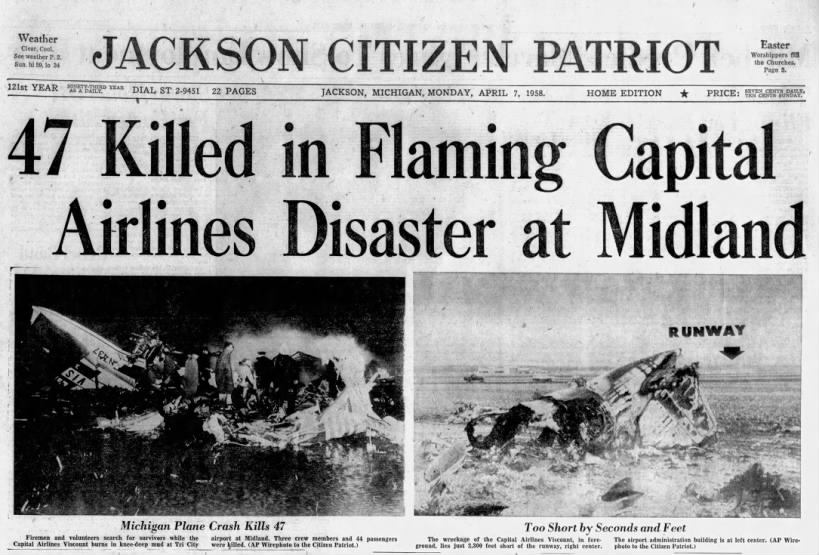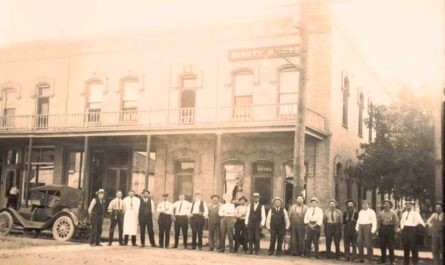Tragedy struck Midland, Michigan, when Capital Airlines Flight 67 crashed, killing all 47 aboard. Investigators pieced together the fatal sequence of events.
Capital Airlines Flight 67 Ends in Fatal Crash Near Midland

MIDLAND, Mich.— On the evening of April 6, 1958, Capital Airlines Flight 67, a British-made Viscount turboprop airliner, met a fiery end just short of the runway at Freeland Tri-City Airport. (MBS International Airport) The aircraft, carrying 44 passengers and three crew members, nosedived into a muddy field, killing everyone on board. Witnesses described an orange fireball followed by an explosion, sealing the fate of those aboard instantly.
Capital Airlines Flight 67 Faces Fatal Mid-Air Failure
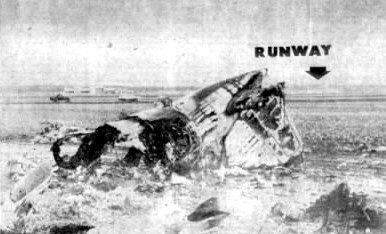
The flight originated in Newark, New Jersey, and was en route to Chicago with scheduled stops in Detroit, Flint, and Saginaw. As it approached Tri-City Airport in Midland, the four-engine Viscount encountered difficulties. Eyewitness Nelson Girardin recounted how the aircraft’s lights flickered through the evening drizzle before it suddenly pitched downward. Seconds later, an explosion and flames illuminated the night sky.
Authorities, including the Civil Aeronautics Board (CAB), launched an immediate investigation. They found no evidence of an onboard explosion before impact, shifting focus toward mechanical or weather-related causes.
Eyewitnesses Describe a Scene of Horror and Chaos
Locals near the crash site rushed to help but were met with burning wreckage and no signs of survivors. Girardin, who had driven to the airport to pick up a friend, described seeing the plane’s nose hit the ground before flipping onto its back. “There was no chance for anyone to survive,” he said.
Emergency personnel worked overnight, recovering the remains and investigating the cause. The wreckage was scattered over a wide area, and many bodies remained strapped in their seats. Temporary morgues were set up at the Dow Chemical hangar and the National Guard Armory in Saginaw.
Mechanical Failure or Severe Weather? Investigators Search for Answers
Initial speculation focused on potential icing of the aircraft’s control surfaces, a known issue for turboprop planes in cold, wet conditions. Capital Airlines introduced the Viscount in 1955, a decision that was met with both optimism and scrutiny. While the aircraft was celebrated for its quiet ride and fuel efficiency, concerns about performance in icy conditions persisted.
Investigators found that Flight 67’s descent was rapid and uncontrolled, suggesting the pilots had little time to react. Reports indicated that the aircraft’s approach to the airport was normal until moments before the crash, leaving experts to debate whether mechanical failure or weather conditions played the primary role.
A Tragic Twist of Fate for Some Passengers
The crash was particularly devastating for some families. Two Saginaw Valley residents had driven their relatives to Flint to board the ill-fated flight rather than waiting for it at Tri-City. Among them was Mrs. N.W. Carpenter, whose husband had taken her to Flint’s Bishop Airport so she could have a better seat. “She wanted to see the country,” he later recalled, overwhelmed by grief upon learning of the crash.
Similarly, sailor Raymond Merrill, returning to Great Lakes Naval Training Center, had been driven to Flint by his father to ensure he would get to Chicago on time. Both Carpenter and Merrill perished in the accident.
Capital Airlines’ Troubled History with the Viscount
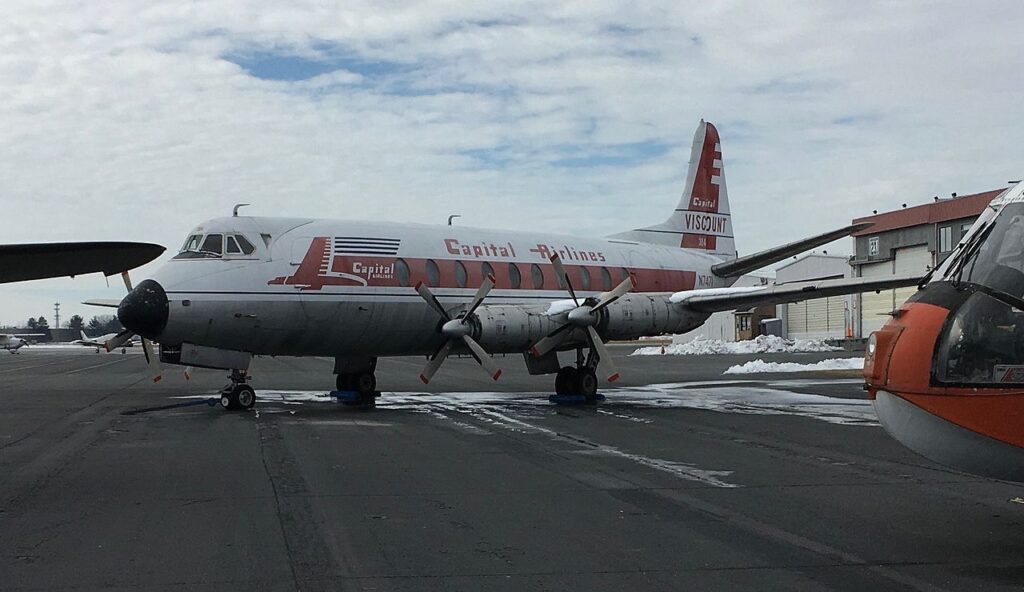
The Viscount was a cutting-edge turboprop aircraft, but Capital Airlines had faced financial struggles and operational difficulties. The airline had purchased 60 Viscounts, gambling on their promise of fuel efficiency and passenger comfort. However, some experts believed the airline’s rapid expansion and financial instability led to lapses in maintenance and pilot training.
A year prior to the crash, Capital Airlines had been offered a financial lifeline by a major U.S. aircraft manufacturer in exchange for an order of medium-range jets. At the time of Flight 67’s disaster, the airline was operating at a loss, raising questions about whether cost-cutting measures had played a role in the accident.
The Lasting Impact of the Capital Airlines Flight 67 Crash on Aviation Safety
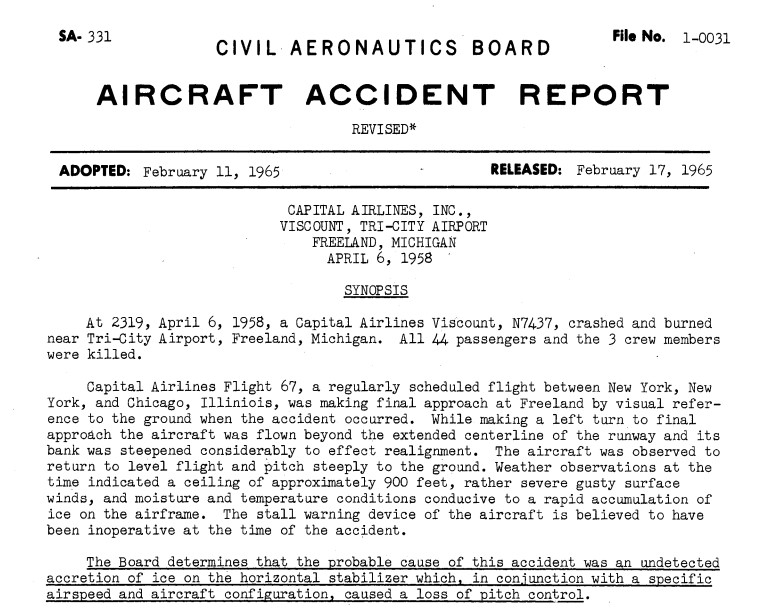
The Civil Aeronautics Board determined that the crash’s probable cause was undetected ice accumulation on the horizontal stabilizer, which led to an uncontrollable loss of pitch control. Additionally, investigators found that the aircraft’s stall warning device was likely inoperative at the time of the accident, preventing the crew from receiving a crucial alert before the stall occurred.
In response, the Federal Aviation Administration (FAA) mandated that all Viscount aircraft maintain fully operational stall warning devices at all times. The airline industry also took steps to improve de-icing procedures, particularly for turboprop aircraft operating in adverse weather conditions.
Further safety improvements were made in the following years, including upgrades to airport weather observation equipment and increased pilot training on stall recovery techniques. The accident also highlighted the need for better visibility markers at smaller airports like Tri-City, leading to the eventual installation of automated runway visibility measuring systems across U.S. airports.
These reforms were crucial in shaping modern aviation safety standards, ensuring that lessons from Flight 67’s tragedy would prevent similar disasters in the future.

Capital Airlines would eventually merge with United Airlines in 1961, ending its independent operations. Flight 67 remains a reminder of the risks of early turboprop aviation and the challenges of balancing innovation with safety.
Find More Interesting Feature Stories From ThumbWind
- Michigan Feature Stories – Unveiling the diverse and vibrant people, captivating places, and remarkable events that come together to make the Great Lake State unique and cherished by both residents and visitors alike.
- Weird Political News – A sarcastic take on official news from around the U.S., exploring the absurdities that often arise in the political landscape while providing a humorous perspective on current events and highlighting the quirks of politicians and policies.
- Michigan News – News and events from Michigan’s Upper Thumb region worth knowing, including local stories, impactful interviews, and updates on community happenings that shape the culture and lifestyle of the area.
Your Turn – Like This, or Loath it – We Want To Hear From You
Please offer an insightful and thoughtful comment. We review each response. Follow us to have other feature stories fill up your email box, or check us out on ThumbWind Publications.

